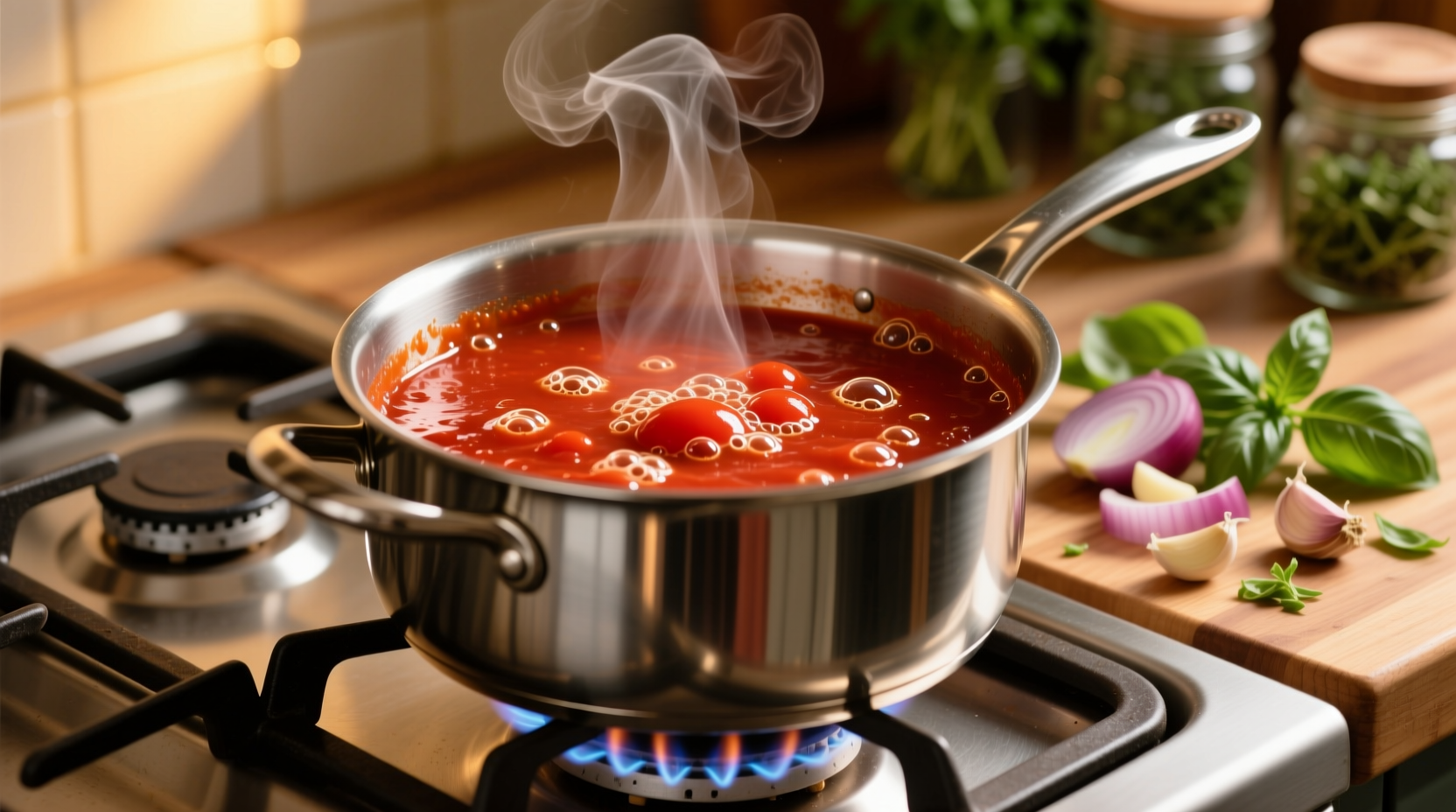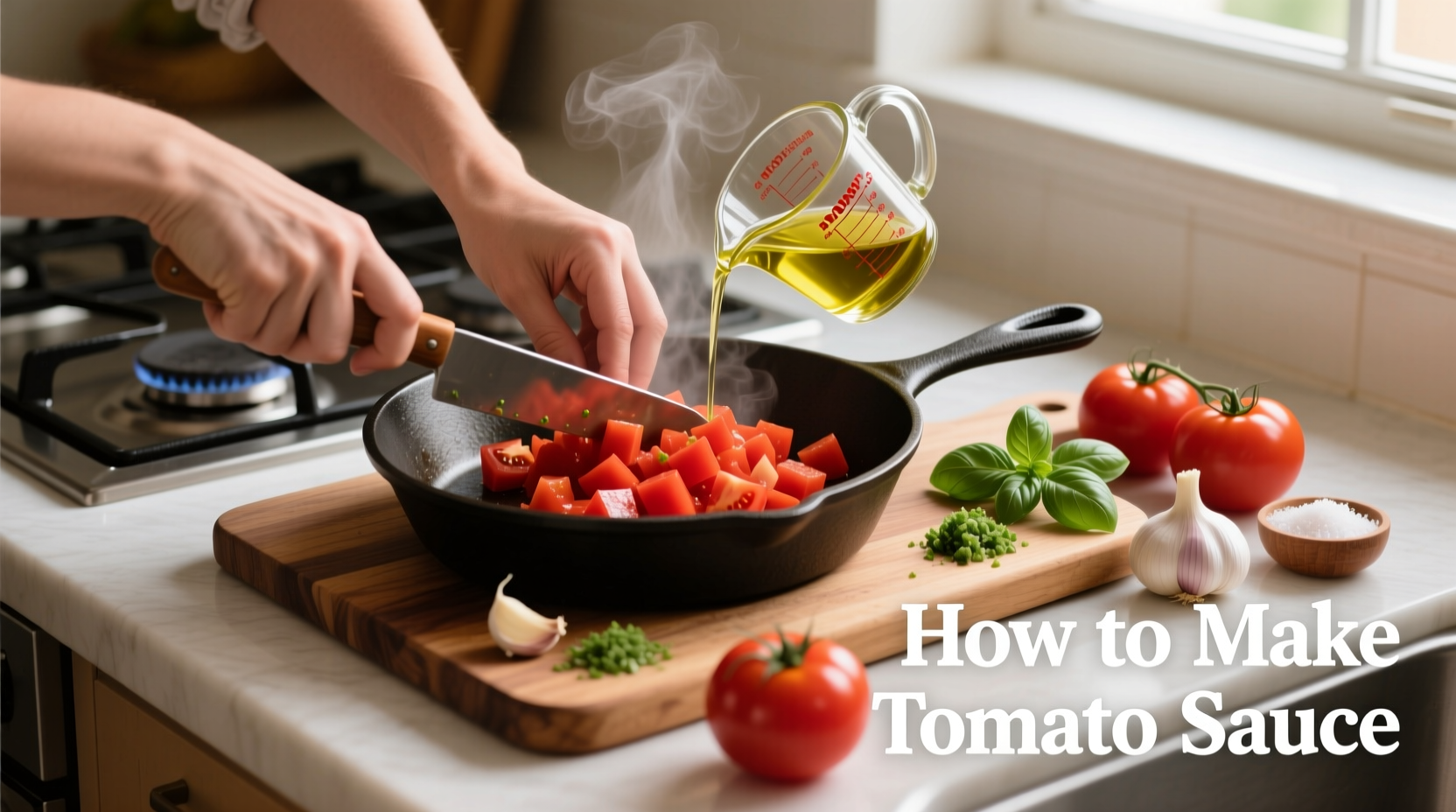Make perfect homemade tomato sauce in just 30 minutes with 6 essential ingredients: ripe tomatoes, olive oil, garlic, onions, basil, and a pinch of salt. This authentic recipe yields a rich, versatile sauce that outperforms store-bought versions, with professional techniques for depth of flavor and proper consistency.
Nothing beats the vibrant flavor of freshly made tomato sauce. Forget jarred versions with preservatives and artificial flavors—this simple recipe delivers restaurant-quality results using pantry staples. Whether you're pairing it with pasta, using it as a pizza base, or incorporating it into casseroles, our tested method ensures consistent results every time. You'll learn the science behind flavor development, common mistakes to avoid, and how to customize this versatile sauce for any dish.
The Essential Tomato Sauce Foundation
Creating exceptional tomato sauce starts with understanding the core components. While variations exist across regions, the fundamental technique remains consistent among professional chefs. The magic happens through controlled reduction and proper ingredient sequencing—never add all ingredients at once.
| Tomato Variety | Flavor Profile | Best For | Acidity Level |
|---|---|---|---|
| Roma (Plum) | Earthy, concentrated | Classic Italian sauces | Medium |
| San Marzano DOP | Sweet, low acidity | Premium sauces, pizza | Low |
| Cherry | Bright, fruity | Quick sauces, fresh applications | High |
| Canned Whole Peeled | Consistent, balanced | Year-round reliability | Medium |
According to agricultural research from University of California Cooperative Extension, San Marzano tomatoes contain 30% less acidity than standard varieties, explaining their prized sweetness in authentic Neapolitan cooking. When fresh tomatoes aren't in season, high-quality canned whole peeled tomatoes provide consistent flavor year-round.
Step-by-Step Sauce Preparation
Yield: 4 cups | Prep: 10 minutes | Cook: 20-25 minutes
Essential Ingredients
- 2 lbs (900g) ripe tomatoes or 2 cans (28 oz each) whole peeled tomatoes
- 3 tbsp extra-virgin olive oil
- 1 medium yellow onion, finely diced
- 4 garlic cloves, minced
- 1 tsp sea salt (adjust to taste)
- 5-6 fresh basil leaves
- 1 tsp sugar (optional, balances acidity)
Professional Technique
- Sweat the aromatics: Heat olive oil over medium-low. Add onions with pinch of salt and cook 8-10 minutes until translucent (not browned). This builds flavor foundation without bitterness.
- Garlic timing matters: Add minced garlic during last 2 minutes of onion cooking. Garlic burns easily—high heat destroys its delicate compounds.
- Tomato transformation: Add tomatoes with their juice. For canned tomatoes, crush by hand before adding. Bring to gentle simmer (never boil rapidly).
- Controlled reduction: Simmer uncovered 15-20 minutes, stirring occasionally. Sauce is ready when it coats the back of a spoon.
- Final seasoning: Remove from heat. Stir in fresh basil and adjust salt. Let rest 10 minutes before serving.

Avoiding Common Sauce Mistakes
Food science explains why certain techniques make or break your sauce:
- Overcooking tomatoes: Extended high heat breaks down pectin, creating watery sauce. Simmer gently after initial reduction.
- Incorrect acid balance: If sauce tastes too sharp, add 1/4 tsp baking soda (not sugar) to neutralize acidity chemically.
- Using dried basil: Heat destroys dried basil's volatile oils. Always finish with fresh herbs for vibrant flavor.
- Skipping the rest period: Allowing sauce to rest lets flavors meld through molecular diffusion.
Customization Options for Every Palate
Adapt this base recipe to suit dietary needs and flavor preferences while maintaining authenticity:
Dietary Adaptations
- Vegan version: Naturally plant-based—ensure no cheese additives in store-bought alternatives
- Low-sodium option: Replace salt with 2 tbsp nutritional yeast for umami depth
- Allium-free: Omit onions/garlic; use 1 diced carrot and celery for sweetness
Regional Variations
- Neapolitan style: Add 1/4 cup fresh oregano and omit basil for authentic pizza sauce
- Arrabbiata: Include 1-2 dried red chilies with garlic for spicy version
- Creamy tomato: Stir in 1/4 cup heavy cream after cooking (never during simmering)
| Time Period | Key Development | Historical Source |
|---|---|---|
| 16th Century | Tomatoes introduced to Europe from Americas | Encyclopædia Britannica |
| 1790 | First recorded tomato sauce recipe in Italian cookbook | Vincenzo Corrado's "Il Cuoco Galante" |
| 1840s | Tomato sauce becomes staple in Southern Italy | Archival records from Naples |
| 1920s | Commercial canning enables year-round availability | USDA Food Processing History |
Proper Storage Techniques
Follow USDA food safety guidelines for proper preservation:
- Cooling: Transfer sauce to shallow container; cool to 70°F within 2 hours
- Refrigeration: Store in airtight container for up to 5 days (40°F or below)
- Freezing: Portion into ice cube trays, then transfer to freezer bags (6 months)
- Canning: Requires pressure canning for safety—pH must be below 4.6
The USDA Food Safety and Inspection Service emphasizes that improper cooling is the #1 cause of foodborne illness in homemade sauces. Never store hot sauce directly in the refrigerator.
Troubleshooting Guide
Solve common sauce problems with these chef-tested solutions:
- Too thin: Simmer uncovered 5-10 minutes OR create cornstarch slurry (1 tsp cornstarch + 1 tbsp cold water)
- Too thick: Gradually add reserved pasta water or vegetable broth
- Bitter taste: Balance with 1/4 tsp sugar or 1 tbsp grated carrot
- Lack of depth: Add 1 tsp fish sauce (umami booster that disappears during cooking)
Maximizing Your Sauce
Extend your sauce's versatility beyond pasta:
- Use as pizza base (spread thin for proper crisping)
- Stir into scrambled eggs for shakshuka
- Thin with broth for hearty soup base
- Marinate proteins before grilling
- Freeze in portions for quick meal starters
Professional chefs maintain that the secret to exceptional sauce lies in ingredient quality and controlled cooking temperature. As Antonio Rodriguez notes, "The difference between good and great tomato sauce comes down to respecting the ingredients' natural chemistry—gentle heat unlocks flavors that boiling destroys."











 浙公网安备
33010002000092号
浙公网安备
33010002000092号 浙B2-20120091-4
浙B2-20120091-4